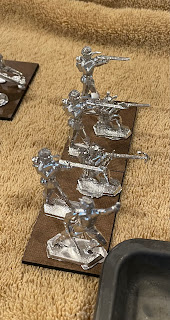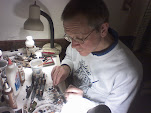This winter has been a quiet season for my wargaming hobby, but I am hoping that spring inspires me to some fresh activity.
I thought I would get back in the game with a review of Fantastic Battles by Nic Wright. Fantastic Battles (copyright 2020) is a generic fantasy mass battle game. It is available as a PDF from Wargame Vault for about $11, and as a POD hardcopy from Amazon for about $20.

In considering whether I am going to purchase a new set of rules the basing conventions are the first thing that concerns me. I have vowed to avoid rebasing my miniatures collections at all costs, so I became interested in Fantastic Battles when I learned (from discussions on the Lead Adventure Forum) that it was intended for troops based on squares with a small number of individually based characters to act as commanders. 60mm bases are recommended for 25mm figures, and 40mm for smaller figures. Conveniently, this is how most of my 25mm fantasy collection is based, so it would have seemed like looking a gift horse in the mouth to reject the opportunity to purchase and try these rules. I should note here that there are also some minor suggested rules changes to account for the use of troops on rectangular bases.
6mm Fantastic Battles with rectangular bases
The actual rules are about 40 pages long, including the lists of spells and unit attributes (“traits”) described below. There are also four pages devoted to a short campaign system (to be played on a node-and-link map of areas and communications routes), a selection of twelve fantasy armies with points precalculated for suggested units types which cover the usual fantasy trops (humans, halflins, dwarves, elves, goblins, ratmen, lizard men, and undead) plus a set of twelve mostly historical army lists in six matched pairs ranging from Greeks and Trojans to Conquistadors and Aztecs. The book concludes with a two page quick reference sheet.
The rules describe themselves as “setting agnostic”, which is to say that there is no specific background given, and the army construction rules should allow you the flexibility or build whatever sort of fantasy army you like. Each “company” (a single one of the square bases mentioned previously) is built from a basic type (elite, formed, irregular, fantastic beast, dragon, artillery, or vehicle) customized by adding some of the forty traits to it. An army can have one overall defining trait (say “Drilled” for Romans or Gondorians) and each unit can have up to three additional traits. For example, a company of knights might be an elite company with “mounted” and “furious charge”. Each company has five basic statistic: resolution (number of hits it can sustain), move (in base widths or “BWs”), melee (number of dice thrown in combat), shooting (number of dice thrown at short and long range), and defense (target number for an enemy’s attack rolls), plus a base point cost for purchase. The various traits will alter those numbers. Mounted, for example, increases resolution, move, and melee, as well as increasing the cost. There are negative traits as well. “Militia”, for example, reduces melee (and cost). Each company’s final statistics and cost are the sum of the base type values plus all of the selected trait values. Costs range from about 25 for an irregular company of goblin warriors to 50 or more for a company of elite knights.
The rules recommend playing with an army cost of about 750 points, and some points will need to be allocated to the command characters. These come in four basic types, warlord, magician, captain, and rogue. They cost between 25 points for a captain or rogue and 75 points for a combined warlord/magician. So, a 750 point army might consist of three or four characters and perhaps 15 companies (with an average cost of 40). The game recommends playing a battle this size on a table 30 BW by 20 BW. For 60mm bases that would work out to be 4x6 feet. For 40mm bases, a dining room table is probably sufficient.
Before the battle each player organizes his companies into units of one to four identical companies. These units will be permanent for the duration of the battle. Units of more than one company may adopt one of three formations, line, column, and tortoise, and may change between them as needed during the game. These units pool the resolution points of all the component companies, so that a unit of four companies of irregular goblins at 3 resolution points each would have a total resolution of 12, and will be removed entirely when it takes 12 hits, with no intermediate removals of companies. So you can organize your army into bulky units with good staying power, or smaller flexible units which are more brittle.
Each turn during the game will consist of three phases: shooting, actions (i.e. maneuvers), and melee. In the shooting phase, all companies with a shooting ability and within range of an enemy may shoot. Shooting and melee both use the same dice system; a number of dice per shooting company is rolled, and any that equal or exceed the target’s defense value reduce the unit’s resolution. Markers of some sort, or a roster system, will be needed to track hits during a game. At the end of the shooting phase any units which have taken more hits than their resolution rating are removed, so units always have a chance to shoot back before elimination.
In the “actions” phase, each player has a number of tokens in a cup (or cards in a deck). These are drawn one at a time. The first draw for each player will activate all of their “impetuous” units, which is defined as those beyond the command radius of a character. Impetuous units roll a six-sided die, and have a 50% chance of moving as the player wishes; otherwise they will be compelled to retreat, charge, or hold. After the impetuous units are dealt with, each draw will allow the player to activate one character and the units within their command radius. Units may perform various maneuvers; characters have additional possibilities such as spell casting or rallying troops. Enemy units about to be contacted by a unit of the active player may (depending on traits) be able to perform a response, such as evasion or countercharge.
Romans flanking the elves; note cards for initiative and dials to mark hits
When all tokens have been drawn and all actions completed, there is a melee phase. All units in contact roll melee dice against the defender’s target number as with shooting. Bonus dice are available for the usual sorts of situations, such as charging and flanking. Successes reduce the target’s resolution, and, like shooting, destroyed units are removed at the end of the melee phase and therefore still fight back.
The mechanics are fairly simple and straighforward. Players with any background in wargames with miniatures should be able to oick them up quickly. Based on our trial games so far, players should be able to finish a 750 point recommended size game in under two hours, even allowing some time to look up a few rules as you go. The electronic version of the rules also includes an Excel spreadsheet which will calculate unit costs and allow you to print a basic army list. I would recommend that you add a short description of the effect of any trait in your army with special rules (i.e., that involves more than a simple modification of the five statistics). That would have saved us most of the lookup time in our trial games.
Despite my having purchased these rules to use with my 25mm collection, we have been playing the trial games so far with 6mm figures from Irregular (mostly) on 40mm WRG bases of varying depths, using the suggest rectangular base modifications.
Overall, the games we have played have been fun. I would recommend these rules if you need a rank-and-flank set of mass fantasy battle rules which provide a good two-player experience in a game lasting less than two hours and playable on a 4x6 table (in 25mm; your dining room table in smaller scales). We have not tried a multi-player game. I don’t expect that I will be using this for a six to eight player convention game to fill a four hour time slot. I note that my opponent thought our first game was enough fun that he immediately ordered a 6mm elf army from Baccus and has been painting it…



























